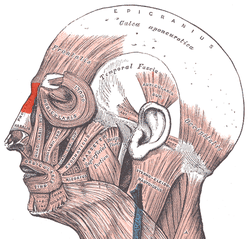Procerus muscle
| Procerus | |
|---|---|
 Muscles of the head, face, and neck. (Procerus visible at upper left, at top of nose.) | |
| Details | |
| Origin | From fascia over the lower of the nasal bone |
| Insertion | Into the skin of the lower part of the forehead between the eyebrows |
| Artery | facial artery |
| Nerve | Buccal branch of the facial nerve |
| Actions | Draws down the medial angle of the eyebrow giving expressions of frowning |
| Identifiers | |
| Latin | musculus procerus, pyramidalis nasi, depressor glabellae |
| TA | A04.1.03.008 |
| FMA | 46769 |
The procerus is a small pyramidal slip of muscle deep to the superior orbital nerve, artery and vein. Procerus is Latin, meaning tall or extended.
Structure
The procerus arises by tendinous fibers from the fascia covering the lower part of the nasal bone and upper part of the lateral nasal cartilage.
It is inserted into the skin over the lower part of the forehead between the two eyebrows on either side of the midline, its fibers merging with those of the frontalis.[1]
Function
The procerus helps to pull that part of the skin between the eyebrows downwards, which assists in flaring the nostrils. It can also contribute to an expression of anger.
Procerus is supplied by temporal and lower zygomatic branches from the facial nerve. A supply from its buccal branch has also been described.[2] Its contraction can produce transverse wrinkles.
References
This article incorporates text in the public domain from the 20th edition of Gray's Anatomy (1918)
- ↑ "eye, human."Encyclopædia Britannica from Encyclopædia Britannica 2006 Ultimate Reference Suite DVD 2009
- ↑ "Nose, nasal cavity and paranasal sinuses" CHAPTER 32. Gray's Anatomy
Additional Images
 Procerus muscle (red).
Procerus muscle (red).